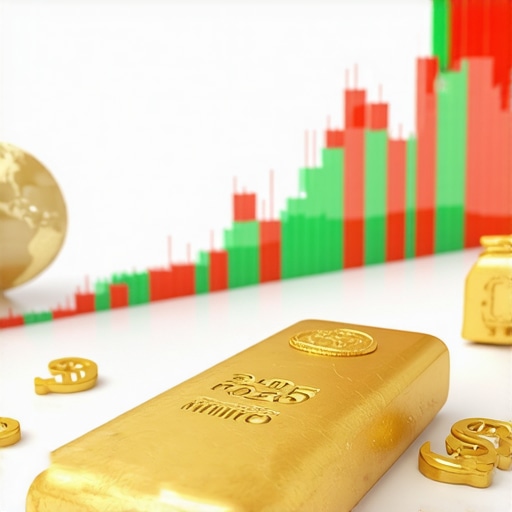Understanding the Factors Influencing Gold Demand
Gold has long been considered a safe haven asset, prized for its intrinsic value and historical significance. However, the factors influencing gold demand are multifaceted, ranging from economic indicators to geopolitical tensions. In this article, we will explore the key elements that shape the demand for gold in today’s market.
Economic Indicators and Gold Demand
One of the primary factors driving gold demand is the state of the economy. When economic stability is threatened, investors often flock to gold as a protective measure. For instance, during periods of inflation, gold is perceived as a hedge, preserving wealth against the devaluation of currency. This trend is particularly highlighted in our article on how inflation affects your gold investment strategy. Furthermore, low interest rates can increase gold’s appeal, since the opportunity cost of holding non-yielding assets like gold diminishes.
Geopolitical Tensions and Their Impact
Geopolitical instability significantly influences gold demand. Events such as conflicts, trade disputes, or political unrest can create uncertainty in the markets, prompting investors to seek refuge in gold. This is often referred to as the “safe haven” effect, where gold’s value is seen as more stable compared to volatile financial markets. Understanding these geopolitical factors can provide insights into market trends, as discussed in our analysis of central bank gold purchases.
Supply and Demand Dynamics
The fundamentals of supply and demand also play a critical role in shaping gold prices. Gold mining production, recycling rates, and the demand from industries such as electronics and jewelry contribute to the overall market dynamics. When demand outpaces supply, prices typically rise, making it essential for investors to stay informed about these market conditions. For more detailed insights, check out our comprehensive guide on understanding gold prices.
Investment Trends and Gold
Investment trends, including the increasing popularity of gold ETFs and mutual funds, have also bolstered demand. As more investors seek to diversify their portfolios, gold has become a staple in asset allocation strategies. Our article on investing in gold ETFs provides valuable insights into why this trend continues to grow.
In conclusion, the demand for gold is influenced by a confluence of factors that include economic indicators, geopolitical tensions, supply and demand dynamics, and evolving investment trends. Understanding these elements is crucial for investors looking to navigate the gold market effectively. To delve deeper into gold investment strategies, visit our guide on gold investment. By staying informed about these factors, investors can make more strategic decisions in their gold investment journey.
Global Economic Factors Shaping Gold Prices
The global economy has a profound impact on gold prices. Factors such as currency fluctuations, trade agreements, and international economic policies can significantly affect gold demand. When the U.S. dollar weakens, gold becomes cheaper for foreign investors, often leading to increased demand. For a deeper understanding of how these elements interact, check out our article on understanding gold price influencers.
Inflationary Pressures and Gold Investment
As inflation rises, many turn to gold as a safeguard against currency devaluation. Historically, gold has held its value during inflationary periods, making it a preferred choice for preserving purchasing power. Our detailed analysis on how inflation affects your gold investment strategy discusses this relationship further.
Central Bank Policies and Their Effect on Gold
Central banks play a crucial role in influencing gold prices through their monetary policies. When central banks purchase gold, it typically signals confidence in the asset, which can drive prices higher. Conversely, when they sell off their gold reserves, it can lead to price declines. For insights into the implications of these actions, refer to our piece on central bank gold purchases.
Shifts in Consumer Demand for Gold
Consumer demand for gold, particularly in emerging markets, significantly affects its price. Countries like India and China are among the largest consumers of gold, primarily for jewelry and investment purposes. Understanding these trends is vital for investors looking to capitalize on market movements. Our article on understanding gold demand trends provides a comprehensive overview of this topic.
Jewelry Demand vs. Investment Demand
The demand for gold can be categorized into two main segments: jewelry and investment. While jewelry demand tends to rise during festive seasons, investment demand is more influenced by economic conditions and market trends. For a detailed comparison of these segments, check out exploring the role of gold as a portfolio hedge.
Technological Advances and Gold Utilization
Technological innovations have also influenced gold demand, particularly in electronics and renewable energy sectors. As new technologies emerge, the requirement for gold in various applications can lead to shifts in demand. For example, gold’s conductivity makes it a vital component in electronic devices. Learn more about these trends in our article on analyzing gold supply and demand.
Gold Recycling and Its Market Impact
Another significant aspect of gold supply is recycling. The recycling of gold from old jewelry and electronic waste can impact market supply and prices. As new technologies make recycling easier and more efficient, the overall supply of gold can increase, potentially stabilizing prices. For insights into how recycling shapes the gold market, visit our guide on understanding gold prices.
In summary, gold prices are influenced by a complex interplay of global economic factors, consumer demand, technological advances, and central bank actions. Staying informed about these trends is essential for anyone looking to navigate the gold market effectively. For more comprehensive insights into gold investment strategies, explore our guide on gold investment.
Market Speculation and Gold Prices
Market speculation plays a significant role in determining gold prices. Traders and investors often react to geopolitical events, economic reports, and central bank statements, leading to price fluctuations. For those interested in how speculation impacts the gold market, our article on what you need to know about gold trading techniques offers valuable insights.
The Influence of Geopolitical Events
Geopolitical tensions, such as conflicts, trade wars, and political instability, can drive investors toward gold as a safe haven asset. When uncertainty looms, gold prices often surge as investors seek to protect their assets. To understand the relationship between geopolitical events and gold prices, check out the case for gold as a reliable investment hedge.
Interest Rates and Gold Valuation
Interest rates are another critical factor affecting gold prices. Typically, when interest rates rise, the opportunity cost of holding gold increases, leading to lower demand. Conversely, lower interest rates make gold more attractive as an investment. For a deeper dive into how interest rates impact gold valuation, consider our piece on 2025 gold price trends: understanding market signals.
Gold as a Long-Term Investment Strategy
Investing in gold should be viewed as a long-term strategy rather than a short-term gain. While prices may fluctuate, gold has historically maintained its value over time, making it a solid component of a diversified investment portfolio. For a comprehensive guide on integrating gold into your investment strategy, visit best gold investments for beginners.
Balancing Gold with Other Investments
To maximize returns, investors should balance gold with other asset classes such as stocks and bonds. This diversification can reduce risk and enhance overall portfolio performance. For tips on how to effectively diversify your investments, explore our article on how to effectively diversify with gold investments.
Gold Investment for Retirement Planning
Gold can also play a vital role in retirement planning, particularly through options like Gold IRAs. These accounts allow investors to hold physical gold as part of their retirement savings, providing a hedge against inflation and market volatility. Learn more about this approach in our detailed guide on exploring gold IRA options for retirement planning.
Future Predictions for Gold Prices
Looking ahead, the future of gold prices is influenced by a myriad of factors, including economic growth, inflation rates, and investor sentiment. Analysts often provide predictions based on current market conditions and historical data. To stay ahead of the curve, read our article on 2025 gold price forecast: insights and predictions.
Analyzing Market Signals for Gold Investments
Understanding market signals is crucial for making informed gold investment decisions. Factors such as gold supply and demand dynamics, technological advancements, and changing consumer preferences all contribute to price movements. To explore these signals in depth, refer to our piece on analyzing gold market trends for better investments.
In conclusion, navigating the intricate world of gold investment requires an understanding of various market dynamics, consumer behaviors, and economic indicators. As you consider your investment options, it’s essential to stay informed and utilize resources that provide comprehensive insights into the gold market. For further exploration, check out our complete guide on gold investment: a comprehensive guide to buying gold.
Key Factors Influencing Gold Prices
The gold market is complex and subject to a range of influences that can affect prices. Understanding these factors is critical for anyone considering investing in gold. Here are some key influencers:
Global Economic Indicators
Economic indicators such as GDP growth, unemployment rates, and manufacturing output can significantly impact gold prices. Strong economic performance typically reduces gold’s appeal as a safe haven, while economic downturns can lead to increased demand for gold. For an in-depth look at how these indicators affect your investment, see our article on understanding gold prices: key influencers and trends.
Currency Strength and Gold Valuation
The strength of major currencies, particularly the U.S. dollar, plays a crucial role in gold pricing. When the dollar weakens, gold becomes cheaper for foreign investors, often driving up demand and prices. Conversely, a strong dollar can lead to lower gold prices. To gain a better understanding of currency impacts, check out our post on 2025 gold price trends: understanding market signals.
Market Sentiment and Investor Behavior
Market sentiment, shaped by investor psychology and trends, can lead to rapid price changes in the gold market. Positive sentiment towards gold can drive up prices, while negative sentiment can have the opposite effect. Investors should be aware of how broader market trends can impact their gold investments. For insights on investor behavior, refer to our article on the best gold investment strategies: expert insights.
Central Bank Policies and Gold Demand
Central banks play a key role in the gold market, particularly in terms of demand. Their decisions regarding gold purchases or sales can greatly influence market prices. When central banks increase their gold reserves, it can lead to upward price pressure. To delve deeper into this topic, explore our post on analyzing the impact of central bank gold purchases.
Inflation and Gold as a Hedge
Gold is often viewed as a hedge against inflation. As inflation rises, the purchasing power of currency declines, leading investors to seek out gold as a store of value. Understanding the relationship between inflation and gold prices is crucial for making informed investment decisions. For more on this relationship, visit our article on how inflation affects your gold investment strategy.
Supply and Demand Dynamics in Gold Market
Gold supply and demand dynamics significantly impact pricing. Factors such as mining output, recycling rates, and jewelry demand can all influence market balance. For a comprehensive analysis of these dynamics, refer to our piece on analyzing gold supply and demand: what to expect.
Conclusion: Navigating Gold Investment Strategies
In conclusion, understanding the myriad factors influencing gold prices is essential for savvy investors. From economic indicators to central bank policies and market sentiment, each element plays a pivotal role in shaping the landscape of gold investment. As you explore your options, remember to utilize reliable resources to stay informed and make educated decisions. For a broader view of gold investment strategies, take a look at our comprehensive guide on gold investment: a comprehensive guide to buying gold.
Frequently Asked Questions about Gold Investment
As an investor navigating the complexities of the gold market, you may have various questions regarding gold investment, pricing, and market dynamics. Below are some commonly asked questions that can help deepen your understanding.
What Factors Affect Gold Prices?
Gold prices are influenced by several factors, including global economic indicators, currency strength, market sentiment, central bank policies, inflation rates, and supply and demand dynamics. Understanding these elements can help investors anticipate price movements.
Is Gold a Good Investment During Inflation?
Yes, gold is often viewed as a hedge against inflation. When inflation rises, the value of currency decreases, prompting investors to seek gold as a stable store of value. This behavior tends to increase demand and subsequently raises gold prices.
How Do Central Banks Influence Gold Prices?
Central banks can significantly impact gold prices through their purchasing and selling activities. An increase in gold reserves by central banks can lead to upward pressure on prices, while selling off reserves can have the opposite effect.
What Role Do Currency Strength and Gold Valuation Play?
The value of major currencies, particularly the U.S. dollar, affects gold pricing. A weaker dollar makes gold more affordable for foreign investors, potentially increasing demand and prices. Conversely, a strong dollar can depress gold prices.
How Can I Invest in Gold?
Investors can consider various methods to invest in gold, including purchasing physical gold (such as coins or bars), investing in gold ETFs (exchange-traded funds), or buying shares in gold mining companies. Each option has its pros and cons, so it’s essential to evaluate your investment strategy carefully.
What Are the Risks of Investing in Gold?
While gold can be a safe haven, it is not without risks. Price volatility, geopolitical tensions, and changes in monetary policy can affect gold prices. Investors should be aware of these risks and consider diversifying their portfolios to mitigate potential losses.
How Do Supply and Demand Affect Gold Prices?
The balance between gold supply and demand is crucial in determining prices. Factors such as mining output, recycling rates, and demand for jewelry can influence this balance. An increase in demand without a corresponding rise in supply often leads to higher prices.
Where Can I Find Reliable Information on Gold Investment?
For reliable information on gold investment, consider visiting reputable financial news websites, government reports, and academic literature. Resources such as the World Gold Council, Financial Times, and Bloomberg provide valuable insights and analysis on gold markets.
What Are the Best Strategies for Investing in Gold?
Successful gold investment strategies often involve thorough research, diversification, and a clear understanding of market trends. Investors should stay informed about economic conditions and central bank policies while regularly reviewing their investment portfolios.
Conclusion: A Comprehensive Perspective on Gold Investment
In summary, understanding the multifaceted factors influencing gold prices is essential for investors looking to navigate the gold market successfully. By being aware of economic indicators, central bank actions, and market sentiment, investors can make informed decisions and optimize their gold investment strategies. As you explore your options, leverage reliable resources and stay up-to-date with market trends to enhance your investment journey.










